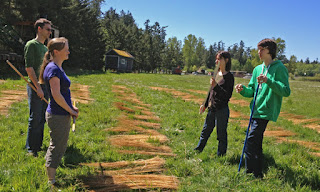Retting
There are many stages of processing the flax before you can spin it into linen thread. Retting (rotting) is the first stage. This is where the flax straw needs to be broken down to get to access to the fibre.
 |
| loading up flax bundles into truck 26.03.2013 |
We had the use of Nancy's truck to haul rippled flax to a field at SHAS (Saanich Historical Artifact Society) which they are kindly letting us use to ret our flax.
 |
| flax retting crew 03.2013 |
Nancy, Brenda, Rita, Liz, Katherine & me (Barb) taking the picture, getting loads of flax to lay out in the field at SHAS to dew ret.
 |
| dew retting flax at Saanich Historical Artifact Society 05.04.2013 |
A group untying the bundles and spreading the flax out on the grass to dew ret. It needs to be spread out a bit so you can see the grass underneath. In the spring it gets enough dew through the night to moisten the flax and start the retting process. Every few days the section of flax has to be flipped over to expose the other side to the dew. We left a larger than usual space between bundles and the rows (we had the room) as it made it quicker to flip the section without tangling up with its neighbour.
 |
| Bonnie flipping flax 05.04.2013 |
Bonnie is using a stick to slide under the seed end of the loose
bundle.
 |
| Bonnie flipping flax 05.04.2013 |
Then lift that end up and....
 |
| Bonnie flipping flax 05.04.2013 |
Flip it over on it's roots. Now it gets left for another
few days to ret that side. You might have to do this
a few times - flipping it back and forth until the straw is
retted enough to break easily when dried.
How long you leave it depends on the weather.
It takes longer to ret if the days are very hot but
if there is moisture in the air or rain you have to check it more often and turn it frequently.
 |
| flax flippers 05.04.2013 |
 |
| testing the flax ret |
Checking the flax to see if it's retted enough to bring in to dry. If you bend the flax straw and hear it snap a little as it breaks and you can give it a little scrubby motion at the break and it exposes the fibres easily then it's ready to bring in to dry completely. When dry it's ready to begin the process of getting the fibre separated from the straw (boon), which is breaking, scrutching & hackling.
The flax now needs to be bundled again - for stooking and for easy handling and storage in the barn later. We hauled flax back and forth from the barn to the field several times. Sometimes we had a pickup (which saved tons of time) and other times we stuffed our cars full.
 |
| ken bundling retted flax |
Ken straightening a handful of flax to be tied into a bundle.
This was a nice sunny warm day which is best for tying bundles. They should not be tied & stored wet as they will keep rotting and the fibre would be weakened and darker. Towards the end of retting it was raining a lot & we did what we could, but everything was getting pretty wet. The stooks were just about sitting in water at that time so when they went to the barn they were put back into stooks there to finish drying. The dry bundles were stacked loosely. We didn't get it all done so we'll be retting again in the Spring of 2014. Thank goodness we have a dry place for it all.
Pictures of storage in the barn are on the Harvest tab.
Beatrice, Brenda, Liz, Murray, Rita, Dechan, Barb in these pictures


 |
| Hauling the retted flax back to the barn in whatever is available. |


No comments:
Post a Comment